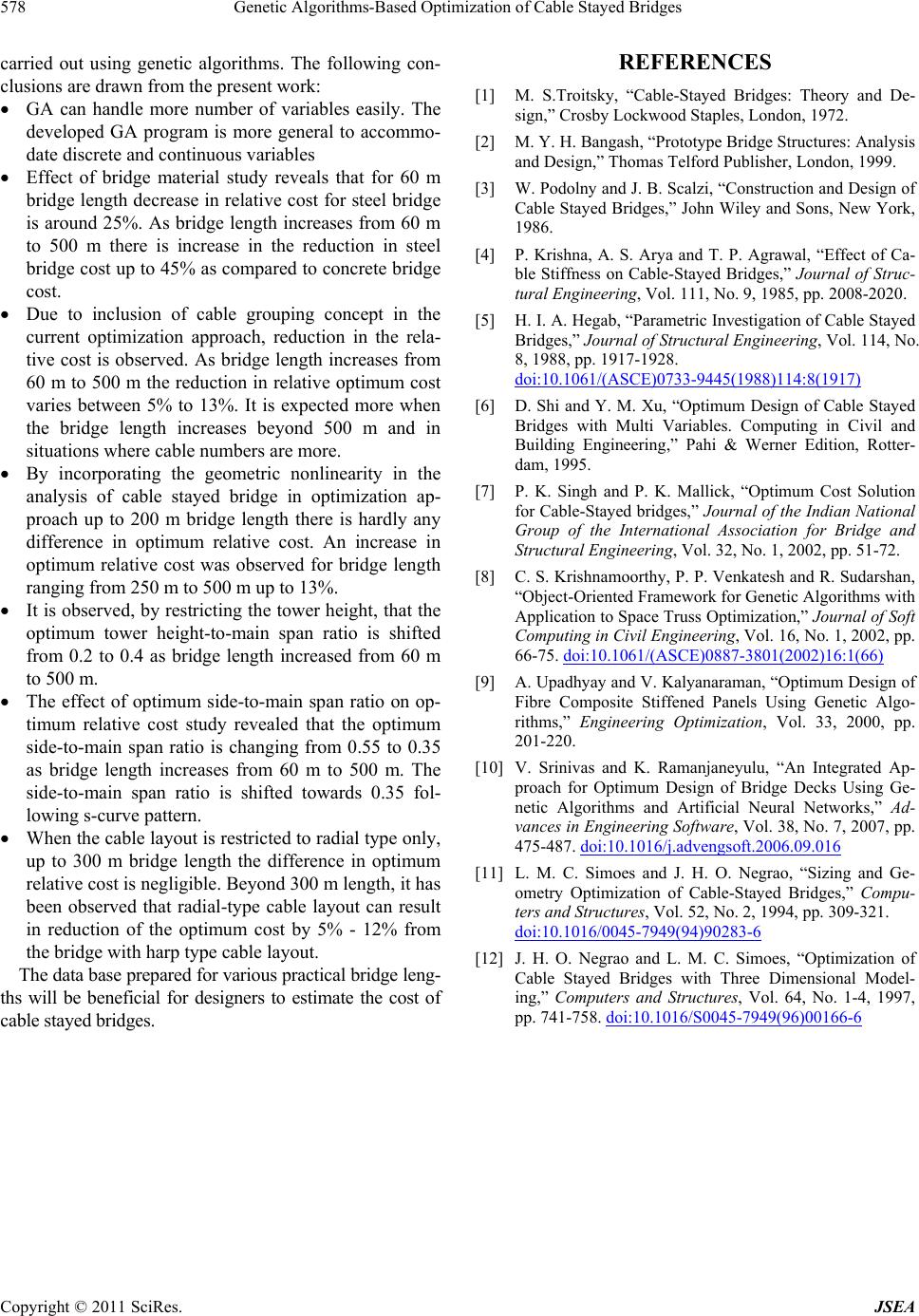
Genetic Algorithms-Based Optimization of Cable Stayed Bridges
Copyright © 2011 SciRes. JSEA
578
carried out using genetic algorithms. The following con-
clusions are drawn from the present work:
GA can handle more number of variables easily. The
developed GA program is more general to accommo-
date discrete and continuous variables
Effect of bridge material study reveals that for 60 m
bridge length decrease in relative cost for steel bridge
is around 25%. As bridge length increases from 60 m
to 500 m there is increase in the reduction in steel
bridge cost up to 45% as compared to concrete bridge
cost.
Due to inclusion of cable grouping concept in the
current optimization approach, reduction in the rela-
tive cost is observed. As bridge length increases from
60 m to 500 m the reduction in relative optimum cost
varies between 5% to 13%. It is expected more when
the bridge length increases beyond 500 m and in
situations where cable numbers are more.
By incorporating the geometric nonlinearity in the
analysis of cable stayed bridge in optimization ap-
proach up to 200 m bridge length there is hardly any
difference in optimum relative cost. An increase in
optimum relative cost was observed for bridge length
ranging from 250 m to 500 m up to 13%.
It is observed, by restricting the tower height, that the
optimum tower height-to-main span ratio is shifted
from 0.2 to 0.4 as bridge length increased from 60 m
to 500 m.
The effect of optimum side-to-main span ratio on op-
timum relative cost study revealed that the optimum
side-to-main span ratio is changing from 0.55 to 0.35
as bridge length increases from 60 m to 500 m. The
side-to-main span ratio is shifted towards 0.35 fol-
lowing s-curve pattern.
When the cable layout is restricted to radial type only,
up to 300 m bridge length the difference in optimum
relative cost is neglig ible. Beyond 300 m length , it has
been observed that radial-type cable layout can result
in reduction of the optimum cost by 5% - 12% from
the bridge with harp type cable layout.
The data base prepared for various practical bridge leng-
ths will be beneficial for designers to estimate the cost of
cable stayed bridges.
REFERENCES
[1] M. S.Troitsky, “Cable-Stayed Bridges: Theory and De-
sign,” Crosby Lockwood Staples, London, 1972.
[2] M. Y. H. Bangash, “Prototype Bridge Structures: Analysis
and Design,” Thomas Telford Publisher, London, 1999.
[3] W. Podolny and J. B. Scalzi, “Construction and Design of
Cable Stayed Bridges,” John Wiley and Sons, New York,
1986.
[4] P. Krishna, A. S. Arya and T. P. Agrawal, “Effect of Ca-
ble Stiffness on Cable-Stayed Bridges,” Journal of Struc-
tural Engineering, Vol. 111, No. 9, 1985, pp. 2008-2020.
[5] H. I. A. Hegab, “Parametric Investigation of Cable Stayed
Bridges,” Journal of Structural Engineering, Vol. 114, No.
8, 1988, pp. 1917-1928.
doi:10.1061/(ASCE)0733-9445(1988)114:8(1917)
[6] D. Shi and Y. M. Xu, “Optimum Design of Cable Stayed
Bridges with Multi Variables. Computing in Civil and
Building Engineering,” Pahi & Werner Edition, Rotter-
dam, 1995.
[7] P. K. Singh and P. K. Mallick, “Optimum Cost Solution
for Cable-Stayed bridges,” Journal of the Indian National
Group of the International Association for Bridge and
Structural Engineeri ng, Vol. 32, No. 1, 2002, pp. 51-72.
[8] C. S. Krishnamoorthy, P. P. Venkatesh and R. Sudarshan,
“Object-Oriented Framework for Genetic Algorithms with
Application to Space Truss Optimization,” Journal of Soft
Computing in Civil Engineering, Vol. 16, No. 1, 2002, pp.
66-75. doi:10.1061/(ASCE)0887-3801(2002)16:1(66)
[9] A. Upadhyay and V. Kalyanaraman, “Optimum Design of
Fibre Composite Stiffened Panels Using Genetic Algo-
rithms,” Engineering Optimization, Vol. 33, 2000, pp.
201-220.
[10] V. Srinivas and K. Ramanjaneyulu, “An Integrated Ap-
proach for Optimum Design of Bridge Decks Using Ge-
netic Algorithms and Artificial Neural Networks,” Ad-
vances in Engineering Software, Vol. 38, No. 7, 2007, pp.
475-487. doi:10.1016/j.advengsoft.2006.09.016
[11] L. M. C. Simoes and J. H. O. Negrao, “Sizing and Ge-
ometry Optimization of Cable-Stayed Bridges,” Compu-
ters and Structures, Vol. 52, No. 2, 1994, pp. 309-321.
doi:10.1016/0045-7949(94)90283-6
[12] J. H. O. Negrao and L. M. C. Simoes, “Optimization of
Cable Stayed Bridges with Three Dimensional Model-
ing,” Computers and Structures, Vol. 64, No. 1-4, 1997,
pp. 741-758. doi:10.1016/S0045-7949(96)00166-6